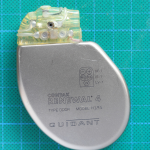Last year's omnibus appropriation bill passed by Congress made a good start with cybersecurity standards for internet-connected medical devices. But it's only one tiny piece of a large and complex puzzle.
Medical Devices
Once a medical device is brought to market, FDA surveillance of its safety continues. “To facilitate incremental improvements in safety and effectiveness, the FDA allows manufacturers to modify previously approved devices.” Only a few of those modifications require additional clinical testing. How often are those modified devices recalled? Is there cause for concern?
EPIC is arguably THE electronic health record system in the US with the most significant market share (56% of all patient records). Countless millions of federal money have passed into their corporate coffers during our transition to digital record keeping. Artificial intelligence, which is more sizzle than steak, at least medical care has been held out as a grail where the data held in electronic health records could be fashioned to improve medical care. A study from JAMA updates us on that particular marriage.
2020 has gotten off to a rough start for both vaping supporters and critics. A new policy by the Trump Administration has both sides angry, and a new anti-nicotine policy by U-Haul, the self-moving company, appears to be blatantly discriminatory.
When we talk about cost and price transparency, medical devices are rarely mentioned. It represents about 5% of our healthcare spending, or roughly $120 billion in 2017. That's less than the $500 billion we spend on pharmaceuticals. But then as the old saying goes, "a billion here, a billion there, after a while you are talking about real money."
We all understand the impact of a gaping wound, or the wasted appearance of a body overrun by cancer. But often there are more silent and invisible conditions that not only invoke a physical furor, but emotional and psychological pain as well. Type 1 Diabetes is such a malady. Thankfully, major advances are ongoing.
A new nanostructured material selectively destroys bacteria, while leaving eukaryotic cells alone. Antibacterial surfaces such as this are needed for medical devices.
Unwanted microorganisms are a fact of life. Bugs grow everywhere we don't want them, from our showers and sinks to our toilets and toothbrushes. The scummy layers they form, called biofilms, are ugly and disgusting but mostly harmless in these settings. However, when they form on medical devices, such as catheters and implants, they can be life-threatening. A clever new material may prevent that.
The plastic softener found in vinyl toys and medical devices are not harmful to children or adults, according to a distinguished panel of leading physicians and scientists chaired by former U.S. Surgeon General Dr. C. Everett Koop.
The panel, convened by the American Council on Science and Health (ACSH), issued its much-anticipated report after a comprehensive review of the scientific literature concerning the phthalates DEHP and DINP. DEHP and DINP are added to vinyl medical devices and toys, respectively, to provide desirable qualities such as flexibility.





